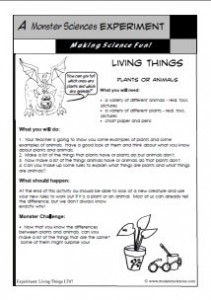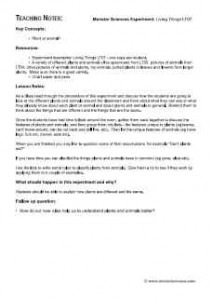This living things experiment allows your students to carefully observe plants and animals and really consider how they are alike and different, even those aspects they may have previously taken for granted.
 |
 |
An experiment about Living Things: Plants and Animals
What you will do:
1. Your teacher is going to show you some examples of plants and some examples of animals. Have a good look at them and think about what you know about plants and animals.
2. Make a list of the things that plants have or plants do but animals don’t.
3. Now make a list of the things animals have or animals do that plants don’t.
4. Can you make up some rules to explain what things are plants and what things are animals?
What should happen:
At the end of this activity ou should be able to look at a new creature and use your new rules to work out if it is a plant or an animal. Most of us can already tell the difference, but we don’t always know exactly why!
Monster Challenge:
• Now that you know the differences between plants and animals, can you make a list of the things that are the same? Some of them might surprise you!
TEACHING NOTES: Monster Sciences Experiment: Living Things LT07
Key Concepts:
• Plant or animal?
Resources:
• Experiment description Living Things LT07 – one copy per student.
• A variety of different plants and animals – live specimans from LT05, pictures of animals from LT04, other pictures of animals and plants, toy animals, potted plants or leaves and flowers from larger plants. Make sure there is a good variety.
• Chart paper and pens
Lesson Notes:
As a class read through the proceedure of this experiment and discuss how the students are going to look at the different plants and animals around the classroom and think about what they can see or what they already know about each plant or animal and about plants and animals in general. Remind them to think about the things that are different and the things that are the same.
Once the students have had time to look around the room, gather them back together to discuss the features of plants and animals, and then group them into lists – the features unique to plants (eg leaves, can’t move around, can be cut back and still live, etc). Then list the unique features of animals (eg have legs, furs etc, moves, eats etc).
When you are finished you may like to question some of their assumptions, for example “Don’t plants eat?”
If you have time you can also list the things plants and animals have in common (eg grow, alive etc).
Use the lists to write some rules to classify plants from animals. Give them a try to see if they work by applying them to a couple of examples.
What should happen in this experiment and why?
Students should be able to explain how plants are different and the same.
Follow up question:
• How do our new rules help us to understand plants and animals better?
© www.monstersciences.com



